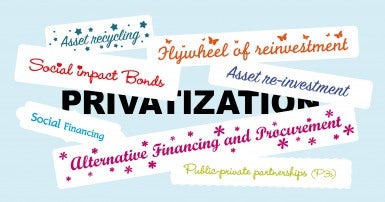 Social impact bonds (SIBs) are a new form of privatization affecting areas such as social services, education and health care. This new model allows investors to profit from public services. Investors provide up-front financing for public programs like health prevention, child care or ending homelessness. If certain outcomes are met, the government pays back investors for the initial program cost, plus a profit.
Social impact bonds (SIBs) are a new form of privatization affecting areas such as social services, education and health care. This new model allows investors to profit from public services. Investors provide up-front financing for public programs like health prevention, child care or ending homelessness. If certain outcomes are met, the government pays back investors for the initial program cost, plus a profit.
SIBs are slowly spreading in Canada, with two federal projects and two in Saskatchewan. The governments of Manitoba and Ontario, as well as the federal government, are exploring new SIBs. It’s important that workers, service users and service providers work together to stop this new form of profiteering, and push for well funded, strong public services.
Here are 10 ways social impact bonds hurt people and public services.
1. There’s no room for profit in our social programs
SIBs allow investors to profit from services to the elderly, those with disabilities, children and those who are marginalized in our communities. Investors can expect to earn anywhere between five and 30 per cent in annual returns. When a project is successful, investors reap the profits, at the public’s expense. Adding profit as an additional financial hurdle only puts more pressure on already tightly funded programs. It’s wrong for private investors to turn a profit off services and supports for the most vulnerable in our society.
2. SIBs direct savings from effective programs into profit
Effective social programs may mean savings for the government, money that can be reinvested into additional services. This grows the overall impact of our social programs. However, SIBs divert any possible savings away from public programs, and into private profit. This reduces the overall amount of money available to spend on social programs.
3. Money is diverted from services to SIB consultants
SIBs involve a wide range of consultants who profit from projects. These include financial intermediaries, project managers, auditors, evaluators and lawyers. One analysis of a federal SIB on essential skills found that 60 per cent of funds were going toward overhead and profits, with only 40 per cent toward the actual program. SIBs involve complex and costly contracts that result in much higher administrative and transaction costs than public sector programs.
4. Simplistic SIB project outcomes damage public services
Publicly funded social programs report regularly on the wide range of ways that services improve people’s lives. However, SIBs base investor profits on a few easily measured outcomes to determine a project’s ‘success’. This can skew programs toward achieving simplistic outcomes. This shift can lead to programs that fail to meet the wide range of needs in our communities, and limits the positive results that come from well funded social programs.
5. SIB service providers are no longer advocates
Social program providers often act as advocates for the people they serve and support. SIBs can alter this role, forcing service providers to focus on potentially harmful project outcomes. In one UK SIB, non-profit agencies received payment for the deportation of homeless individuals. This type of reorientation can conflict with service providers’ values and result in a loss of trust and reputation.
6. SIBs hurt staff wages and working conditions
The competitive market for SIBs can result in deteriorating wages and working conditions for workers. Service providers may compete against others based on labour costs in order to get contracts. SIBs may also result in the increased use of volunteers instead of a paid workforce. Workers also run the risk of being laid off if SIB outcomes are not achieved, resulting in greater instability in an already precarious sector.
7. SIBs can limit access to services
SIBs can create a perverse incentive for service providers to seek out easier-to-help service users. This cherry-picking is done so that the outcomes which trigger investor payment are easier to achieve. It also leaves harder to support service users to whatever public programs remain, or in some cases, without access to any public services.
8. Risk is not shifted to the private sector
Some argue that SIBs shift risk for social services to the private sector, because investors are not supposed to be repaid if project outcomes are not met. However, several strategies are used to minimize the risk to investors. Poorly performing service providers can be replaced mid-project in some SIBs. In other cases, financial guarantees are provided that ensure investors do not lose their entire initial investment. Investors tend to look for projects that limit their exposure to risk and maximize their investment returns.
9. SIBs do not spur innovation in social programs
Rather than being cutting edge, SIBs favour programs that have extensive research showing their effectiveness. For example, an existing child care and parenting support program that had a proven track record was expanded through a SIB. In other cases, the Housing First model, which has extensive research showing its effectiveness, has been used in SIBs. Despite the rhetoric of innovation, SIBs tend to repeat tried and true methods that could easily be delivered through publicly funded and managed programs.
10. SIBs reduce transparency and accountability
SIBs outsource the financing, planning and evaluation of social programs to third parties who are unaccountable to the public. Consultants and investors get unprecedented control over which social programs get funded, what approaches are used and how project success is determined. Private sector involvement in public services means project costs, results and analysis can get cloaked in secrecy.
